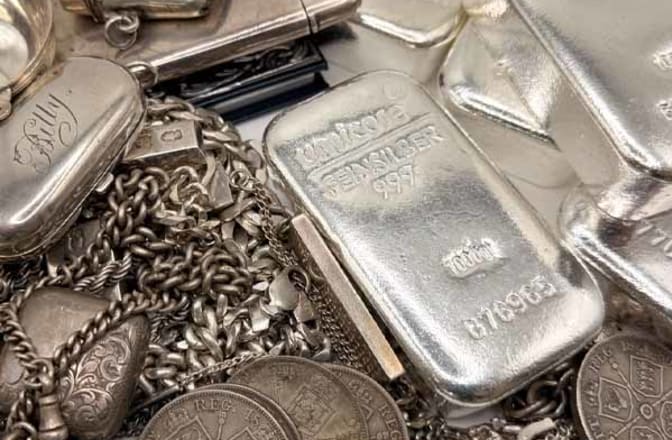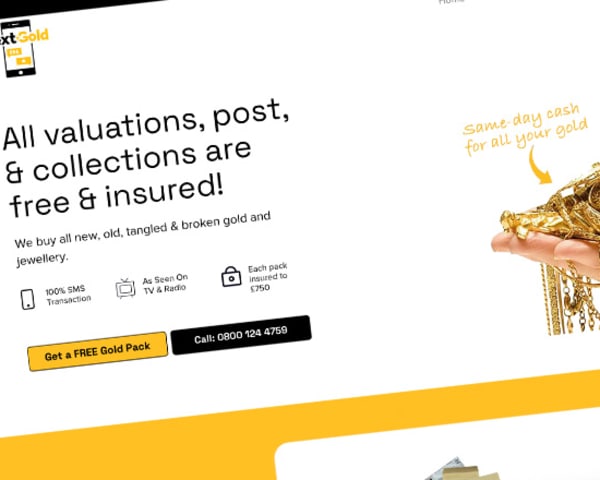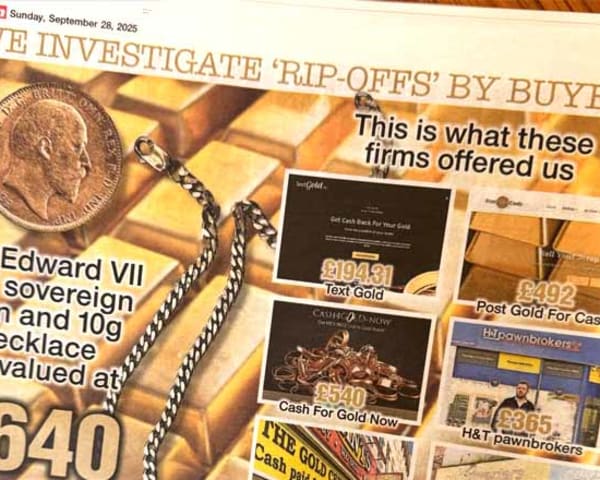Exceptionally high silver lease rates have created a temporary liquidity crisis in the global silver market, forcing refiners to pause normal trading and advance payments. As a result, we're still accepting silver but can't currently buy it at our usual market rate. This disruption is industry-wide and linked to global factors - from rising industrial demand and U.S. stockpiling to BRICS nations buying physical precious metals. Our gold buying rates remain completely unaffected. We're working hard to seek a way through this, and will revise this page when an update is available.
Over the past few days, we've had to make a temporary adjustment to our scrap silver buying rates. This decision hasn't been taken lightly. It reflects some extraordinary pressures within the silver market - pressures that are affecting refiners, traders, and dealers right across the industry.
The situation is complex, involving shortages of physical silver, spiralling financing costs, and policy changes that have shifted global demand. Below, we'll explain what's actually happening, why it matters, and what it means for our customers.
How Scrap Silver Normally Moves Through the Market
Under normal circumstances, the process is simple. When you sell scrap silver to us, we pay you immediately based on the live market rate. We then send that silver to one of our refining partners, who processes it and credits the pure metal to our account.
The refinery will typically advance payment to us as soon as they receive the material, using their own financing arrangements with banks. Once refined, the silver can be sold or traded back into the wholesale market.
That's how the system usually works - smooth, predictable, and well-hedged.
But that process depends heavily on the refineries' ability to borrow silver or cash at normal interest rates while they're holding and processing material. When that financing suddenly becomes very expensive or unavailable, the entire chain begins to seize up.
And that's exactly what's happening right now.
The Problem With Refining Silver in October 2025
Across the global silver market, refiners and bullion banks are facing unprecedented financing costs. The cost of borrowing silver - known as the lease rate - has spiked to levels that are effectively unworkable.
In practical terms, that means it's now uneconomical for refiners to fund the metal they're holding while it's being refined.
Normally, a refiner might take delivery of silver scrap, hedge it in the futures market, and then draw on an overdraft or metal loan to finance the purchase until it's sold. When lease rates rise from, say, 2% to 10%, that's a headache. But when they reach 80% or even 100%, the cost completely wipes out the profit margin - and the risk of holding metal becomes prohibitive.
Refiners have therefore had to pause their normal advancing arrangements. They can still receive silver, they can still refine it, and they can still credit metal accounts. But they cannot release or sell that refined metal into the market until liquidity returns.
That's why we, and every other reputable dealer, have had to adjust our buying rates. It's not a question of unwillingness - it's that the downstream system that normally finances silver trades has effectively locked up.
Why Lease Rates Matter So Much
The silver lease market might sound obscure, but it's vital to the functioning of the entire precious metals ecosystem.
When refiners, jewellers, or bullion traders need to borrow silver for a short period, they pay an annualised interest rate - the lease rate - to borrow metal from a bullion bank. These leases are often only for a few days or weeks.
When those short-term interest rates spike, every part of the trade becomes more expensive. Hedging positions cost more to maintain. Storage and financing costs rise. Dealers become more cautious. And ultimately, physical silver stops moving as freely through the system.
This situation is being described in industry circles as a "liquidity crisis" in the Loco London silver market - the system through which most of the world's physical silver trades are settled.
Signs of Stress in the Silver Market
Several indicators point to how severe this disruption has become:
- Backwardation: Spot prices for immediate delivery have risen above futures prices, a classic sign of shortage.
- Inventory depletion: Vaults in London are reporting reduced stocks of good-delivery bars.
- Financing constraints: Overdraft and short-term borrowing costs for refiners have soared, making it impractical to advance payment on incoming metal.
- Volatile prices: The silver price itself has surged, but movements are erratic, driven as much by financing stress as by supply and demand.
When all of these factors collide, refiners cannot safely or profitably process silver at scale - even though physical demand remains strong.
The Global Picture: Growing Demand Meets Tight Supply
Silver is unique because it straddles both the industrial and investment worlds. It's used in everything from solar panels and electronics to jewellery, investment coins, and bars. Right now, we're experiencing unprecedented demand for the newly released 2026 silver Britannias and pre-owned mixed-date silver Britannias. As fast as we replenish our shelves, demand is outstripping supply.
Right now, demand from all these sectors is running hot.
- Investment demand: Silver-backed exchange-traded funds (ETFs) have seen strong inflows, forcing custodians to source physical bars.
- Industrial demand: Global expansion in solar energy and electronics manufacturing continues to require significant quantities of silver.
- Emerging market demand: Countries like India are seeing renewed appetite for physical silver, often paying premiums above the international price.
That combination means any disruption to the refining and trading system quickly causes a shortage - and once shortages appear, volatility tends to feed on itself.
Policy Shifts: Silver as a Critical Metal
There's also a broader political backdrop to all this.
In September 2025, U.S. President Donald Trump added silver to the list of critical metals and minerals deemed essential to national defence and industrial supply chains. The Pentagon has since accelerated plans to stockpile key materials, including silver, cobalt, and antimony, as part of a wider effort to reduce reliance on China.
While those stockpiling programmes don't directly drain the London silver market, they change investor behaviour. Once a metal is seen as strategically important, both governments and private investors tend to hold it more tightly. Supply available for commercial use can shrink, and speculation tends to increase.
It's another reason why silver feels suddenly scarcer - and more volatile - than it did even a few months ago.
What is BRICS?
BRICS is an alliance of emerging economies: Brazil, Russia, India, China, and South Africa. In 2024, several new countries joined, including Egypt, Iran, Ethiopia, and the UAE.
The group's main objective is to promote economic cooperation and trade settlement that is less dependent on the U.S. dollar. This includes exploring shared payment systems, currency frameworks, and commodity exchanges that settle in local currencies or hard assets rather than dollars.
That may sound abstract, but it has real consequences for global commodity markets - especially precious metals.
Why BRICS Countries Are Buying Gold and Silver
Over the past few years, several BRICS members have been quietly increasing their holdings of physical gold and, to a lesser extent, silver.
There are a few reasons for this:
- Diversification: Gold and silver provide insulation from currency risk and financial sanctions.
- Reserve confidence: Physical metal cannot be frozen or defaulted on, unlike foreign reserves held in another country's banking system.
- Symbolic power: Building bullion reserves signals economic independence and strengthens credibility for any future shared BRICS currency.
- Investment rationale: Many of these nations are also significant metal producers, so retaining more of their output supports domestic industry and buffers them against export volatility.
When large states or blocs start taking physical metal off the open market, it reduces the pool of metal available to commercial users. In other words, BRICS' long-term accumulation of precious metals makes existing supply pressures worse, especially when Western refiners are already struggling with liquidity.
Is the Market Being Manipulated?
It's fair to wonder whether the silver price is being manipulated - the history of the precious metals markets gives people reason to ask.
There have indeed been past cases where banks were fined for misconduct in gold and silver trading. But the current situation appears to stem mainly from liquidity stress rather than deliberate suppression.
That said, the way the market is structured - with a handful of large institutions controlling both physical inventories and paper trading - means that when those players pull back or tighten lending, the effects can look very similar to manipulation. Prices move sharply, liquidity dries up, and smaller participants are left waiting for normal service to resume.
What This Means for Our Customers
We want to be completely transparent.
- We are still accepting silver. You can send or bring in your scrap silver as normal.
- We cannot currently buy at our usual market rate. Because refiners aren't advancing payment to us, the market for scrap silver has effectively slowed down.
- We continue to pay promptly for gold. The gold market remains liquid and unaffected by these financing issues.
- As soon as conditions normalise, our rates will be restored. We monitor the situation daily and will update our website as soon as refiners reopen normal trading channels.
This situation is not unique to us. Every responsible precious metal dealer in the UK - and indeed across Europe - is facing the same challenge.
Glossary
- Loco London: The system through which most global silver trades are settled, using metal stored in London vaults
- Lease Rate: The cost of borrowing metal for a fixed period. High lease rates indicate a shortage or stress in the market.
- Backwardation: A market condition where the spot price is higher than the future price, signalling tight supply.
- Contango: The opposite of backwardation - when future prices are higher than spot.
- Hedging: Taking an offsetting position (usually in futures or forwards) to protect against price movements.
- Refiner Advance: A payment made by the refinery before final settlement, normally backed by their financing arrangements with banks.
In Summary
The silver market is experiencing one of its most unusual periods in recent history. Extreme financing costs, physical shortages, and geopolitical changes have converged to disrupt the normal flow of refined metal.
We continue to buy gold at our normal rates, and we are still accepting silver - albeit under temporary conditions.
As soon as we can forge a working solution, or the underlying liquidity issues are resolved and refiners resume standard payment terms, our buying rates will return to normal. In the meantime, we'll keep our customers informed every step of the way.




